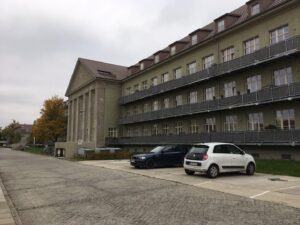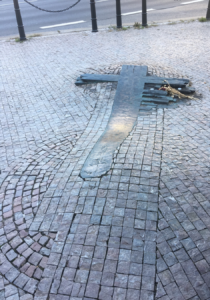
By Jianxiong Zhang (’20)
Unlike the Museum Island in the central Mitte District always busy with tourists and students from all over the world, the Deutsch-Russisches Museum (German-Russian Museum) stands lonely in Berlin’s eastern suburb of Karlshorst. In contrast to the cozy upper-middle class neighborhood today, the location possesses great historical significance in its influence on Germany and East Europe from World War II till today. The museum, which was built to be the office of the German Armed Forces’ Pioneer School, witnessed Germany’s signing of unconditional surrender to the Allied Forces on May 8th, 1945. From then to the founding of DDR in 1949, the building served as the seat of the Soviet Military Administration in Germany. In 1967, it became a museum of surrender, but it was only accessible to members and their relatives of the complex – the KGB headquarters in Germany. Since 1994, the museum became open to the public, but it has never been well-known to visitors of Berlin.


The museum first attracts visitors with four national flags of the countries of its Board of Trustees: Germany, Russia, Belarus, and Ukraine. Although the museum, named German-Russia Museum, documents World War II not only in today’s Russian Federation but the USSR, it was coincidental that the latter three countries were of the four founding republics (except the Transcaucasian SFSR) of the Soviet Union. The T-34 tank on the left of the building tells visitors that it’s a war museum. Indeed, this neighborhood served as the Soviet’s frontline headquarters for the battle of Berlin. It became more obvious that the museum was about the Soviet victory, or the German surrender seeing the gate with the years 1941 and 1945 underlined by слава Великой победы (the glory of victory).


Passing the gate, visitors enter the hall where the German field marshal Wilhelm Keitel signed the unconditional surrender to the Allies on May 8th, 1945. Copies of the original documents were on display next to the desks. The documents were written in English, Russian, and German, with the last point stating that only English and Russian, not German, are languages of authority. The room next to the hall is the office of Marshal Zhukov, who ruled the Soviet bloc of the conquered Germany from 1945 to 1949.

With the founding of East Germany, the building became less useful to the Soviets, and the regime turned it into a museum in 1967. Unlike a normal museum in most people’s minds that are open to the public as a tourist or educational destination, the museum was then only open to the officers working in the neighborhood – the KGB headquarters in Germany. We don’t know whether the objects on display were the same as they are today, but it tells us what a secret and guarded place the surroundings were as the frontline where the KGB and the Stasis collected information from the west. Ironically, the headquarters was turned into a living complex after the German reunification. If you want to enter the building 26 years ago, you need numerous permits and pass strict checkpoints. Today, you just walk in.
Compared to war museums in the city center and Nürnberg, the German-Russian Museum displays World War II with a more Soviet perspective. Hearing the radio recording of then Soviet Foreign Minister Vyacheslav Molotov’s speech on the German invasion on June 22, 1941, we can feel the anxiety and uncertainty from his tones even without any understanding of the Russian language. The speech marked the beginning of the Soviet struggle with millions of civilian deaths. The museum documents another kind of crimes the Nazis committed to the civilians, starvation. People living in Soviet territories were classified as Untermensch (subhuman creatures) under Hitler’s race theory. The strategy the Nazis used was holding up food supplies for a winter and starving most civilians to death. The ones survived the first winter, as Hitler theorized, were the strongest and should be used as slave labors. Forbidden to reproduce, these races would eventually die out. There are also propaganda posters putting the blame of starvation on Stalin for resisting the Germans.

However, the museum also lacks some part of the history, for example, the German-Russian Nonaggression Pact which the two countries divided Poland into their occupation. It reminds me of a recent law passed in Russia forbidding questioning the result of World War II which actually aimed to avoid talks about this pact. At the exit of the museum, there’s a quote from Stalin: „Die Erfahrungen der Geschichte besagen: daß die Hitler kommen und gehen, aber das deutsche Volk, der deutsche Staat bleibt“, I translate as: “the history’s experience says: Hitler comes and goes, but the German people and the German nation stays”, shows us Stalin’s pragmatic approach to the ruling of Germany that he tried to separate the Nazi’s crimes with the German society and to depict the Soviets as the savior of Germany from Nazi’s rule.
The visit to the Deutsch-Russisches Museum has been a great experience for me to understand World War II from the Soviet perspective. As the country with the highest per capita mortality rate during the war, the Soviet’s struggle deserves to be remembered. The subsequent history, as shown in the different usage of the building, tells us more about what happened after the war than objects displayed in the museum.

































